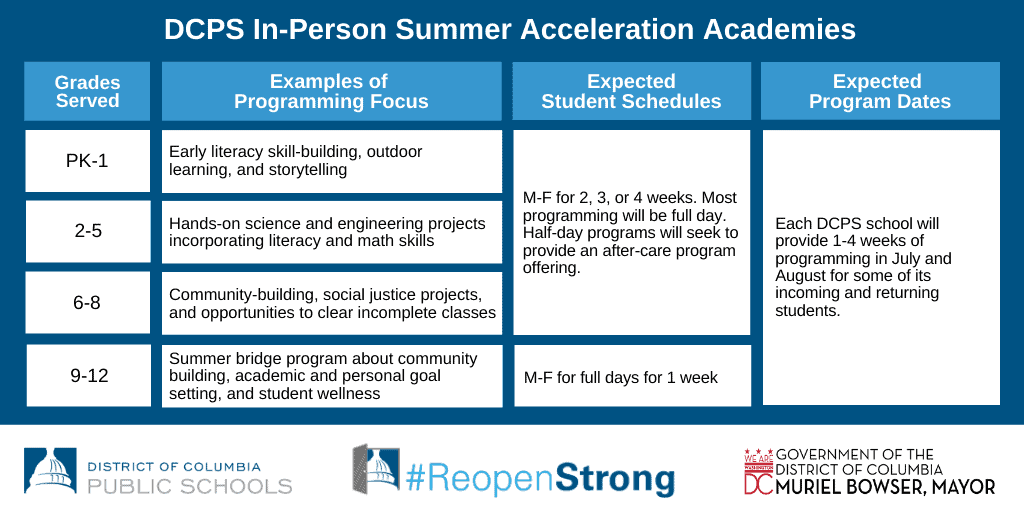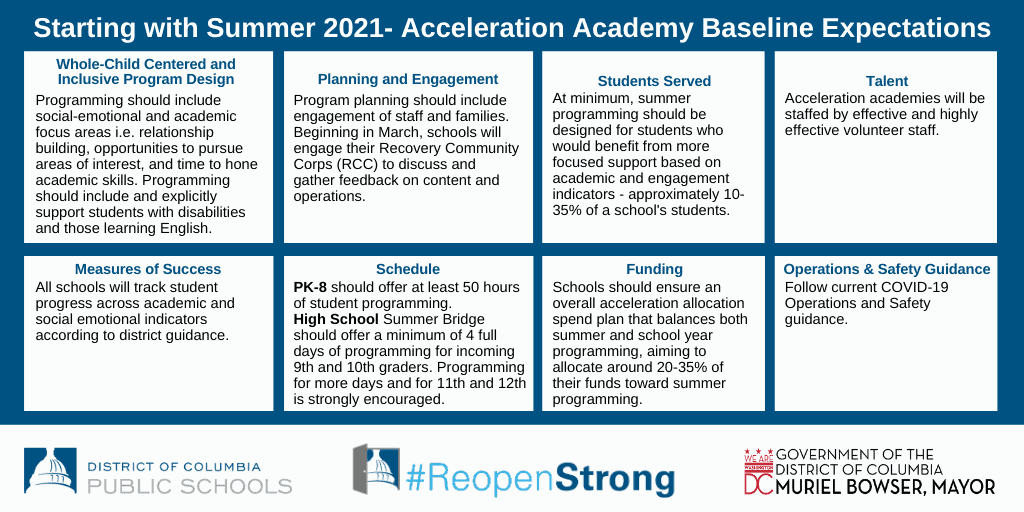From Recovery to Transformation
This page is now archived because it relates to information for a previous school year.
Explore the Family Guide to Summer Learning. Opportunities available for all students.
As we work to recover from the COVID-19 learning slide, we are focused on enhancing the student experience and accelerating student learning. Through collaboration, transparency, and flexibility, we are working to ensure our schools have the resources they need for a strong recovery. DCPS plans to target our federal stimulus dollars to fund initiatives that address the academic and social emotional learning impacts of COVID-19.
Summer 2021

As DCPS begins to #RecoverStrong, this summer is about students exploring the world through acceleration programming and providing opportunities to get a head start on the school year ahead.
Every summer, DCPS provides extended summer learning opportunities such as literacy enrichment for elementary students and credit recovery for secondary students. This summer, we will expand these offerings to include learning supports for every grade, including PK, with a variety of in-person and virtual learning opportunities for up to 7,000 students.
Visit dcps.dc.gov/summer for an overview of each program and look out for registration in early April.
Recovery Community Corps

New this year, schools will also work with their community to develop unique summer learning plans to support social emotional development and academic acceleration ahead of next school year. Building on the Term 3 reopening plan process, schools will take a grassroots engagement approach with a Recovery Community Corps (RCC) of teachers, staff, families, and community members to inform their planning for this summer and beyond.
This work will be rooted in service to the whole child and baseline expectations to ensure equity of access and opportunity across our school community. Guiding this work will be two questions:
- How can schools meet the baseline expectations and the school’s unique goals, while starting to accelerate learning recovery for those students who need it most?
- What is the best way to prioritize supports for students while also ensuring a joyful experience this summer?
Through their RCC planning, schools will determine what their in-person summer acceleration academies will look like. These acceleration academies are designed to serve a targeted group of students at each school (approximately 10 to 35 percent) who require this more focused support. Example programming snapshots are highlighted below, and schools will share more details about their tailored programming in the coming weeks and look out for registration in early April.
Outdoor Learning at DCPS

One of the lessons we are already applying is the interest to provide outdoor learning opportunities. In March, schools received detailed guidance on how to take advantage of the change in seasons and enhance the student experience by offering outdoor instructional programming as early as Term 4 this spring.
Outdoor learning can range from a short period of time outdoors that allows all in-person student cohorts to experience this new approach to instruction, to a full-day, dedicated outdoor classroom experience for students. For Term 4, schools are being asked to consider an outdoor learning approach that is not reliant on technology and prioritizes stability and consistency of programming as we end the school year strong. School-level discussions around whether outdoor learning can be part of summer acceleration academies will be part of the Recovery Community Corps planning process this month.
As shared in our Fiscal Year 2022 budget guide released last month, DCPS is investing $9 million to support in-person learning innovation like outdoor instruction. This means that baseline outdoor learning costs (approximately $2,000 – $10,000 per classroom) will be covered centrally for all schools who are interested in this kind of in-person programming. This type of innovation is necessary as we maximize all the learning opportunities to bring students safely back to school with their classmates and teachers.
Page updated: April 6, 2021


